Archived Article Detail
By Thomas P. Moore
WHAT’S NEW IN THE MINERAL WORLD ARCHIVE – posted on 1/17/2009
January 15, 2009
Yes, it has been a while since the last online report, but among my excuses for the delay are a special project or two, plus the two special supplements coming your way with the turn-of-the-year issues of the Mineralogical Record, plus the personal space-time warps which naturally come with the Christmas season. But now that the holidays are over, the guests have gone home, and the January-February 2009 issue is in the printer’s hands, here’s an online report which goes out particularly to those who can’t attend the Tucson Show, now almost upon us (!). Some of the items described below may show up in Tucson as well, but others may not, and in any case you’ll have Heard It Here First. And by the way, Happy New Year to all.
Minerals On The Web
Road-metal quarries near the village of Osilo, in Sassari Province, northern Sardinia, Italy, have produced modest numbers of good amethystine quartz specimens at intervals since the early 1980’s. At the 2008 Munich Show, Rob Lavinsky of The Arkenstone (www.irocks.com) picked up a group of amethyst specimens which were collected in May 2008 by Luca and Fabrizio Ferrero from the Cupurru quarry, Osilo, and now some of these pretty matrix pieces may be shopped for on Rob’s website. They are miniature and small cabinet-size specimens showing lustrous, pale purple amethyst crystals to 2.2 cm protruding from vugs in pale greenish white, weathered rock. These are not super-dramatic specimens of purple quartz, but they are quite nice for a contemporary—and long-running—European occurrence.
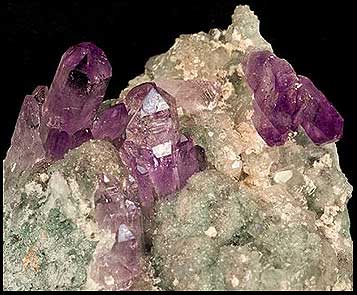
Sardinia, Italy. Arkenstone specimen and photo.
During the 20th century the world’s only fine specimens of the rare zinc phosphate tarbuttite were those from the old Broken Hill mine, Kabwe, Zambia (formerly Northern Rhodesia), wherefrom the species was described in 1908. But a second major locality for well-crystallized tarbuttite came to light in 2003, during early development of the Skorpion zinc mine in the Lüderitz district of far-southern Namibia, where the unusual mineral suite includes not only tarbuttite but hydrozincite, hetaerolite, scholzite, and the new species skorpionite, all occurring as crystals in cavities in sauconite, the zinc-essential clay mineral which is the chief ore exploited by the Skorpion mine. Tarbuttite specimens from this locality had their international debut at the 2007 Munich Show (see the report in January-February 2008), and more have made it to major shows since then, but the best I’ve seen yet are those now being offered by Dirk Kristen of Capetown, South Africa, on the website of his DEKS Minerals dealership (www.deksminerals.co.za). The large-miniature to small-cabinet specimens show gleaming sheaves of pale green, bladed tarbuttite crystals in thick, mounded cavity linings, with dustings of hydrozincite, hemimorphite and white acicular microcrystals of skorpionite. Specimens featuring uncoated, translucent, palest apple-green tarbuttite crystal sheaves are quite attractive, as witness the picture here.
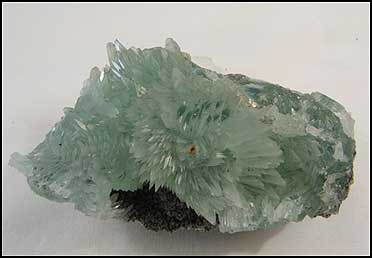
DEKS Minerals specimen and photo.
For the past few years, fairly liberal supplies of brightly beautiful specimens of botryoidal sky-blue hemimorphite have reached the mineral market from somewhere in Yunnan Province, China (bordering northernmost Vietnam). Different dealers have given different reports as regards the source of the specimens, citing, among others, the Dayakou mine, Malipo County; the Dulong mine, Maguan County; and the Wenshan mine, Wenshan County. According to Guanghua Liu’s 2006 book Fine Minerals of China, the hemimorphite hails from the Dulong mine, but U.S. dealer John Veevaert says that the 19 fine specimens he has recently posted on his Trinity Minerals site (www.trinityminerals.com) are from the Wenshan mine. Someday, presumably, we’ll have an unambiguous story here, but meanwhile let us admire John’s specimens, which range from 4.5 to 9 cm across and show baby-blue to deeper, “royal” blue botryoidal coatings of hemimorphite in vugs and veins. These hemimorphite specimens suggest the old blue ones from Sardinia, but they exceed all but the finest of the Italian antiques, both in size and in intensity of color. John’s prices are another pleasant feature: no specimen in the lot costs more than $200, and many cost under $100.
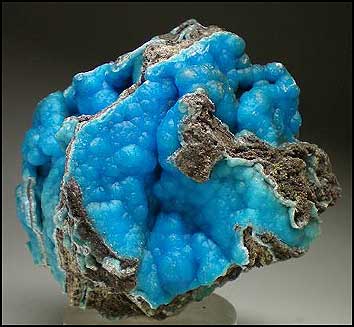
Trinity Minerals specimen; John Veevaert photo.
Early in 2001, in the Boldut mine at Cavnic, Maramures, Romania, there was a discovery of major specimens of the rare sulfosalt chalcostibite (CuSbS2), and now Jordi Fabre’s site (www.fabreminerals.com) offers nine fine miniatures from the find. Sharp, metallic black, bladed chalcostibite crystals form sprays and spherical aggregates to 5 mm, and these thickly populate matrix plates covered by sparkly white druses of quartz and dolomite. Chalcostibite specimens of equal quality (although of very different styles) have come only from Saint-Pons, France and Gar el Anz, Morocco—and these are not to be seen around the market either, except when older collections are recycled. Jordi’s Romanian specimens thus represent a fine chance to broaden one’s “species” representation.
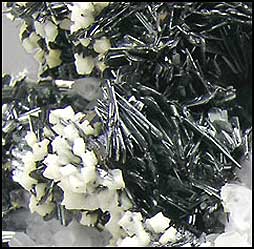
Maramures, Romania. Fabre Minerals specimen and photo.
Also, Jordi right now is marketing a first-class private collection: that of the recently deceased Josep Amigó (1924-2008). Likably, egolessly, Señor Amigó did not name his treasure-hoard after himself but rather called it the Silvane Collection, after his granddaughters Silvia and Ana Elena; the collection consists of about 700 aesthetic thumbnails and miniatures from worldwide localities and is heavy on fluorite and calcite, Amigó’s two favorite species (the writeup by Carlos Curto Milá on Jordi’s site contains more information about the collection). To share in a bit of the viewing pleasure that I experienced last fall at the Munich Show, where Jordi had many Silvane specimens laid out seductively at this stand, check out the two thumbnails pictured below. The Schneeberg proustite, I guess, requires no hype, but I must point out that the bikitaite from the Foote mine, Kings Mountain, North Carolina, is an exceptional thing indeed: the extremely rare hydrated Li-Al silicate is known in fine crystals like this one only from two localities in the world (the other is the type locality: Bikita, Zimbabwe), and this parallel pair of pellucid 2.5-cm crystals is surely the best example of the species you’ll ever see.
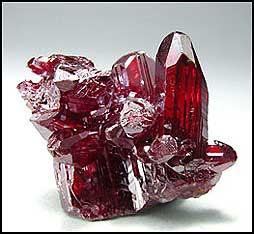
Fabre Minerals specimen and photo.
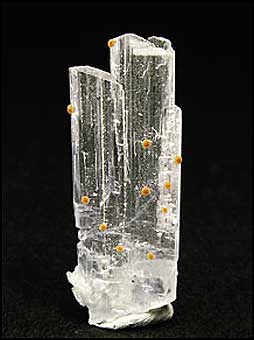
Silvane Collection. Fabre Minerals specimen and photo.
Emanuele Marini of Demineralia (www.demineralia.com) is a specialist in Madagascar minerals whose material I have mentioned before in this space, as well as in printed reports. Available on his site now is a fine selection of loose, gemmy crystals of liddicoatite from various diggings in Madagascar; among their localities are place names we are pretty sure we’ve heard before, e.g. Bevaondrano, Tampo’ny Ilapa, and Anajanabonoina, but there are also crystals from what Emanuele says is a “new find”: the Tsara-fara pegmatite, Ibity, near Antsirabé. From this place come fat, gemmy to part-gemmy, trigonally terminated crystals of liddicoatite to 5 cm long in a range of colors: some mostly pink, some mostly green, and a few which show yellow, bluish and colorless zones in addition to pink and/or green.
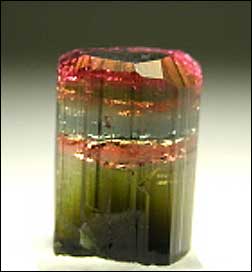
pegmatite, Ibity, Madagascar. Demineralia specimens and photos.
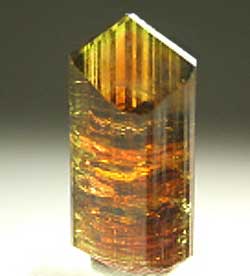
Brian and Brett Kosnar of Mineral Classics (www.minclassics.com) have a December 13 posting of 17 loose, highly etched crystals of petalite from the Palelni mine, Khetchel village, Momeik Township, Burma (Myanmar). This is the same pegmatite locality as has turned out those spiffy colorless drill bit-twinned phenakite prisms we’ve seen around for the last few years, but I first noticed Palelni mine petalite crystals at the 2008 Denver Show, where the Czech dealership KARP had several flats of them (see my Denver report in January-February 2009). The petalite crystals make odd-looking, irregular forms with surfaces like pebbled glass and completely transparent interiors, and surely they are among the world’s best specimens of this species. Whereas the crystals seen at Denver are colorless to faintly brown or gray, the Kosnars’ crystals are palest yellow; that is, the Mineral Classics site thoughtfully shows each crystal against a jet-black background, whereupon it looks yellowish, and then shows the same crystal against a white background, whereupon it looks colorless. The crystals range between 2 and 3.7 cm, and none show any traces of matrix or associated species (whereas a very few phenakite crystals from the Palelni mine rest on white feldspar matrix, with or without quartz crystals—we’re still awaiting matrix petalites of this kind).
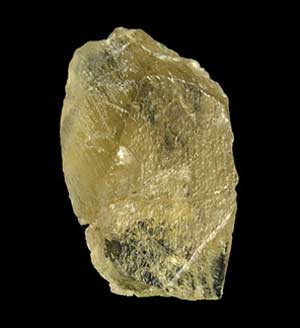
Mineral Classics specimen and photo.
Mike Keim of Marin Minerals (www.marinmineral.com) frequently has something new and attractive, and, sure enough, his posting of November 23, 2008, features aquamarine beryl crystals “mined just weeks ago” from a pegmatite in the Quy Chau district, Nghe An Province, Vietnam. There was, Mike writes, just a single pocket discovery which yielded 27 loose crystals, from 4 to 14.5 cm long. Mike bought them all, and is now asking prices in the low-three-figure range for loose, single crystals—fair enough, as they are lustrous, mostly gemmy, and of a medium-blue to strikingly deep blue color, although most are heavily etched and thus lack sharp prism or terminal faces. Perhaps, in the fullness of time, the mysterious pegmatites of Vietnam will rival those of Brazil and Pakistan for first-rate aquamarine—especially if pockets untouched by etching or resorption processes should be uncovered.
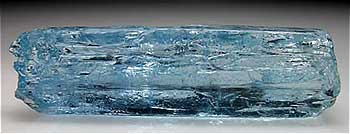
Vietnam. Marin Minerals specimen and photo.
There is a new presence in our Internet Directory: Arrowwood Minerals (www.arrowwoodminerals.com) run by Richard Ertel of Spotsylvania, Virginia. Richard is selling off culls from his own collection and from a friend’s “very large” collection, plus other, miscellaneous stock; his specialties are fine miniature and small-cabinet pieces, Bulgarian minerals, and cerussite. “I collect cerussite,” he writes, “and I am always looking for quality specimens, especially from unusual locales. Let me know if you have display-quality cerussites that you would be willing to trade or sell.” As it is, some very fine cerussites from his collection fill a site-page which is great and educational fun to peruse.
Finally, Canadian Minerals (www.canadianminerals.net) offers a wide assortment of pieces from classic Canadian localities, many “old,” e.g. millerite from the Thompson mine, Thompson, Manitoba; pyrrhotite from the Bluebell mine, British Columbia (this mine closed in the early 1970s); manganite from the Caland Pit, Atikokan, Ontario; and pyromorphite from the Society Girl mine, Moyie, British Columbia (Canada’s only fine pyromorphite occurrence, likewise finished by the 1970s). Also here, more predictably, are good selections of Yukon phosphates, Saint-Hilaire rarities, Nova Scotia zeolites, and other good-neighbor-to-the-north lovelies. One of the Thompson mine millerite specimens, 10.5 cm wide, is exceptional for the occurrence; it posed for the concluding picture in this survey.
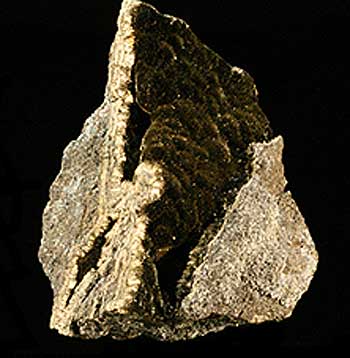
Canadian Minerals specimen and photo.
Show News
Last year, Martin Zinn Expositions L.L.C. added a new show to its regular calendar, and in a “new” part of the country, at that, for mineral shows: it is the Southeast Gem, Mineral & Fossil Show at Cartersville, Georgia. Marty Zinn says that the show’s debut in 2008 went well, and 2009 will see new features added; for instance, a wholesale show will be held at the Tellus Northwest Georgia Science Museum, this concurrently with the retail event at the local Holiday Inn (I-75 Exit 293 and 411 NE, Cartersville). The show will run from 10 a.m. to 6 p.m on Friday August 14 and Saturday August 15, and from 10 a.m. to 5 p.m. on Sunday August 16, 2009. Retail and wholesale dealers who seek information on reserving show space or Holiday Inn rooms, or on renting display cases, should check the website (www.mzexpos.com/southeast.htm). Here’s wishing everyone good luck, good business, and really really good grits (as I understand it, “grits” are some sort of edible specialty in those parts…).
Museum News
Jaroslav Hyršl, the tireless, mineralogically expert citizen of the Czech Republic who spends much of his time investigating mineral occurrences in Peru, reports that in November 2008 a museum opened in Lima wherein, besides a fine small collection of Chancay ceramics (900-1500 A.D.), the splendid Peruvian-minerals collection of Guido del Castillo is on display. The museum has its home in a beautiful 17th-century building, Casa Belén, at Jr. de la Union 1030, in the center of Lima: this facility offers excellent natural lighting for the several hundred superb mineral specimens, all from Peru, in Señor del Castillo’s collection. According to Jaroslav, this is “one of the world’s best collections of regional minerals,” making for “probably the best [mineral] museum in all South America.” Jaroslav describes the Casa Belén in a sidebar to his article on the Turmalina mine, Peru, and its fabulous scheelite crystals: this article will be seen in a future issue of our magazine, but meanwhile you may learn more about the museum by going to www.madc.com.pe/.
Then there is the very exciting news from Freiberg, Upper Saxony, in the former East Germany—yes, the great classic mining district where world-class specimens of silver, acanthite, stephanite, proustite, fluorite, barite, etc., etc. were unearthed for about eight hundred years before World War I, and again briefly after World War II, until final cessation of mining in 1969. The Freiberg Mining Academy, housed in a stately old building in downtown Freiberg, launched its worldwide collection in 1817, upon the death of Abraham Gottlob Werner, “the father of modern mineralogy,” who left his private collection to the Academy. This is still one of the world’s greatest mineral collections, and much more easily visited now, of course, since the fall of The Wall; visitors also may take a tour through the Reiche Zeche (“rich mine”), with mineral displays along the old tunnel walls. But as of October 23, 2008 there’s another excellent reason for mineral lovers to make a Freiberg pilgrimage. That date marked the opening of a lavish public display of minerals in an old castle, Schloss Freudenstein, just a short walk from the Academy building in downtown Freiberg, whose renovation for this purpose began in 2004. The minerals represent part of the fabulous private collection of Switzerland’s Dr. Erika Pohl-Ströher, amassed over a period of 40 years and now on permanent loan to the Freiberg Mining Academy. The display, consisting of more than 5,000 minerals, jewels and meteorites, is called “Terra Mineralia” and is organized by locality, with four “continent halls” devoted respectively to the minerals of Africa, Europe, America and Asia/Australia. (Word is that the African hall is the most impressive of all, thanks to Dr. Pohl’s special fondness for Tsumeb: those who have perused the fine 2007 book Namibia by Ludi von Bezing et al. will have already seen many pictures of Dr. Pohl’s Tsumeb specimens, many never before seen or even illustrated; the publisher, Bode Verlag GmbH, puts “Schloss Freudenstein Edition” on the book’s cover).
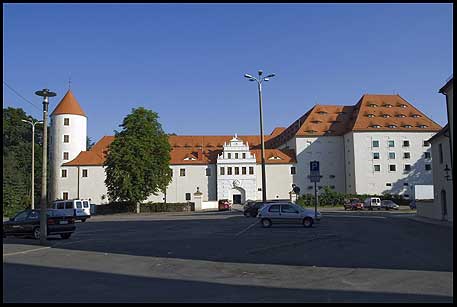
After the grand opening of “Terra Mineralia” there were several days of special events, with films, music, light shows and culinary enjoyments, but the exhibition settled down thereafter into a regular tourist attraction, open Tuesdays through Sundays from 10 a.m. to 6 p.m., admission price 5 Euros. Moreover, there is a spinoff in the form of a book: Terra Mineralia: Highlights From the World of Minerals. This 176-page coffee-table production should serve you well until you can get to Freiberg—the German edition is available now (from Bode Verlag GmbH, Haltern, Germany; price 39.80 Euros); the English edition is scheduled for spring 2009.
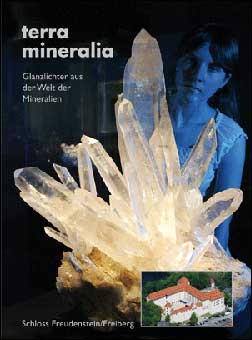
As always, I welcome feedback, but given the calendar date you might save it up and talk to me in person when you come—as of course you will, if you can at all—to the Tucson Show.
For questions about this column, please email Tom Moore.
